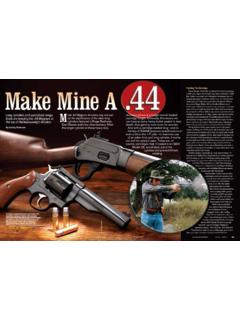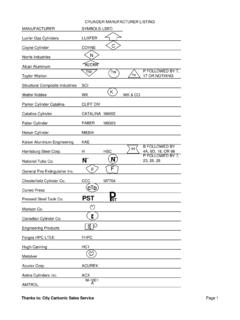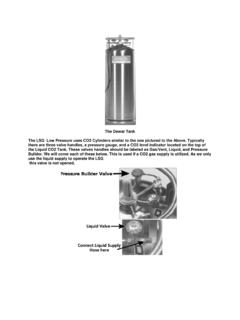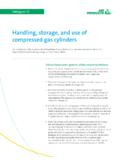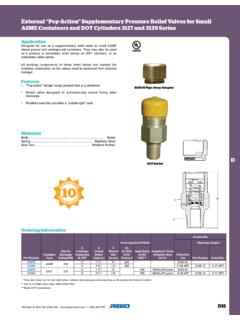Transcription of Class 1, 2, M Hydraulic and Pneumatic Cylinders
1 Class 1, 2, MHydraulic and Pneumatic CylindersClass 1, 2, M Hydraulic and Pneumatic CylindersCLASS 1, 2, M6 NOPAK LOw Pressure CAst HeAd CyLiNdersCLAss 1 CAst HeAd Cylinders For normal applications where low-cost, rugged air Cylinders are required. Our exclusive design has been user-proven with over 80 years of experience as the work horse of industry. Class 2 CAst HeAd Cylinders For higher operating air pressures and Hydraulic use. These Cylinders incorporate recessed gasketed tube seals and piston to rod O-ring seals as standard features. Class M CAst HeAd MiLL tyPe Cylinders These Cylinders have all the features of NOPAK Class 2 Cylinders plus oversize rods and steel tubing with welded flanges and bolted cylinder heads. See page 15. CL1/sVr CAst HeAd/seVere serViCe Cylinders See the Class 1 SVR Section. These extra-rugged units feature over- over-size rods (as compared against competitive models) and extra-heavy duty rod bearing for the most abusive of service.
2 The aforesaid designs, evolving from the evermore challenging demands for gigantic Mill types, now place NOPAK in the welcome the opportunity to quote your most challenging applications. Pressure rAtiNGs (Psi) reCOMMeNded MAXiMuMAirHydrAuLiCCyL. 1, 2, MCLAss 2 Class M1-1/225045065022504506502-1/22504506503 2504506504250450650525045045062504504508 2504504501025045045012250450450142504504 50 APPrOXiMAte uNCrAted Class 1, 2, M CAst HeAd cylinder weiGHts (LBs.) cylinder BOre1-1/222-1/234568101214 Zero Per inch of strokeClass 1, Of CONteNtsNOPAK Low Pressure Cast Head Cylinders ..6 Options, Modifications and Ordering Information ..7 Class 1, 2 & M Cast Head cylinder Cutaway View ..8 cylinder Design and Construction Features . 9 Types of Cushioning Action (Classes 1, 2 and M) 9 Piston Assembly 9 Rod End Detail 9 Parallel Base Mounting ..10 Clevis Mounting ..11 Right Angle Flat Base Mounting ..12 Trunnion Mounting ..14 Class M ..15 cylinder Force, Air Consumption and Torque Values.
3 16 Accessories ..17 Replacement Parts ..18 Reed Proximity Switch .. 1, 2, MOPtiONs BOre siZe The bore size of an air cylinder should be selected to supply from 125% to 200% of the required force. The excess of force versus load will result in a faster cylinder speed assuming there is an adequate supply of air into and out of the cylinder . The bore size of a Hydraulic cylinder should be selected to supply sufficient force to exceed the load by approximately 20%. The cylinder speed is the result of flow into and out of the cylinder . Force tables to aid in cylinder sizing are on page 16. MOuNtiNGs Select the cylinder mounting which will keep the line of force as close as possible to the centerline of the piston rod and free of misalignment. This will maximize seal and bearing life. dOuBLe rOd eNd NOPAK Class 1, 2 and M Cylinders when ordered as double rod end are designated by prefixing the model with letter X. Mounting dimensions may vary from standard because two rod end heads are used.
4 The rod sizes or head models may be interchanged. CusHiONs Unless specified otherwise NOPAK Class 1, 2 and M Cylinders are furnished with self-regulating cushions on both ends. Adjustable cushions or non-cushion Cylinders are also available. See page 9. The purpose of a cushion is to slow up piston speed at the end of the stroke, eliminating shock. The mass to be cushioned should be limited to one-half the cylinder force unless other provisions are made for deceleration or special cushioning. sPeCiAL MAteriALs ANd PLAtiNG Special materials, metals and/or platings are available for various applications including AWWA Specifications. CustOM MOdifiCAtiONs stOP tuBes In long Cylinders used on push applications, internal stop tubes may be necessary to prevent excessive bearing wear. When stop tubes are required with a cushioned air cylinder , a dual or wider piston or similar arrangement is recommended to reduce the trapped air volume and provide the necessary cushion back pressure.
5 OVersiZe rOds An oversize piston rod, 1/4" larger than normal, is available for all Class 1 and Class 2 cylinder diameters except for the 8" which has an oversize rod as standard. Specify rod diameter when ordering. The rod end threading, the rod extension, and related dimensions are shown in Table 2. The oversize rod is a standard feature on NOPAK Class M mill type Cylinders . PistON rOd eXteNsiON ANd rOd tHreAdiNG Longer than standard piston rod extensions may be required to accommodate load fastening. Depending upon the details of rod engagement to load, special threading on rod end configuration may be required. cylinder POrts To increase cylinder speed, increased fluid volume is necessary. This can be done by using enlarged or additional ports. HOw tO OrderAll orders should include the following information:1. Class of cylinder (1, 2 or M).2. Bore or cylinder diameter Stroke length in NOPAK Type of Piston rod diameter and type of rod end threading as 1, 3, 5 or Operating medium (air, oil or water).
6 Also specify:1. Extreme temperatures (below -20 F or above +250 F).2. Minimum pressure (if less than 20 PSI).3. Type of fluid (if other than air, oil or water).4. Unusual operating : Dimensions in inches of ALL Piston Rod Extensions must be taken with the rod retracted. For other than standard piston rod end length dimensions, locate the extreme outboard end of the piston rod in relation to the mounting dimensions of that particular model. Variations in length should be indicated in reference to this dimension. (Related to C dimension designation.)OrderiNG COde eXAMPLeCL1 - 4 x 12 - e - As - - 1 - OPt OPT: Special modification if required. Rod End Thread: See respective model charts for Table 2 for oversized rod details. Mounting styleBore ( " through 14") Stroke (see note above regarding stock sizes) Class (1, 2 or M) Cushion Blind EndCushion Rod End S = self-regulating A = adjustable N = no cushion OPtiONs, MOdifiCAtiONs ANd OrderiNG iNfOrMAtiON8 Class 1, 2 & M CAst HeAd cylinder CutAwAy ViewSectional view of a NOPAK Double-Acting cylinder with Adjustable Cushions.
7 It graphically illustrates 8 other features of NOPAK cylinder construction which contribute to smooth, efficient performance under severe operating conditions. MOuNtiNGs Classes 1, 2 and M are available in the five standard mountings designated as Models A, C, D, E and F, illustrated on pages 10 to 15 1 ANd 2 Cylinders Cylinders are regularly supplied with hard chrome plated steel piston rods*, threaded in one of three types of rod ends (1, 3, 5), fine thread series unless otherwise specified. Alternate 1/4" oversize diameter rods can be accommodated in all standard rod head castings. (Oversize diameter rod is standard in 8" bore and in Class M Cylinders .) Special alloy piston rods can be furnished to specification. Wrench Flats are NOT standard but are available as an option. Dimension C will increase, consult factory. irON ALLOy cylinder HeAds For durability and long life. Through a large combination of standard and special heads, it is possible to furnish Cylinders with mountings for Special Applications.
8 Double rod-end Cylinders can also be seAL V-riNG stACK-PACKiNG On Cylinders 1-1/2" through 6"; three Nylok inserts lock the threaded packing gland in place and maintain proper packing compression. Larger diameters employ a piston rod bushing, packing gland and bolted retainer tuBes Hard coated aluminum material, 1-1/2" diameter thru 8": Honed and chrome plated steel tubing is furnished for 10" thru 14" diameter Cylinders . Class M Cylinders have honed steel tubing with welded GAsKet seAL Between cylinder wall and head on Class 1 Cylinders . Recessed gasket on Class 2 and Class M AsseMBLy: u CuP PACKiNGs, ONe PieCe PistON Furnished as standard. Hi-Temp Seals are available at extra CusHiON Provides variable cushioning capacity, preventing noisy, damaging metal-to-metal impact of piston against cylinder BALL CHeCK-VALVe Assures quick starting under full power. Permits line pressure to act on full piston area instantaneously.* Standard piston rod material is high tensile 100,000 PSI minimum yield, ground, polished, and flash chrome plated.
9 0003 to provide a hard long-wearing surface with low friction. Consult factory for other than air 1, 2, MtyPes Of CusHiONiNG ACtiON (CLASSES 1, 2 AND M)seLf-reGuLAtiNG CusHiON tyPe (Operates Automatically)The self-regulating cylinder head requires no adjustment. Once the cylinder is assembled, its operation is entirely automatic. As the cushion sleeve enters the bore in the cylinder head, the air or fluid is trapped between the piston and the cylinder head, forming a Pneumatic or Hydraulic taper on the cushion sleeve and tolerance between it and bore in the cylinder head provide the self-regulating, positive cushion action. This maximum cushion effect remains constant at all times without needing CusHiON tyPeThe adjustable cushion is often desirable where load relations to cylinder capacity are apt to vary a great deal. After the cushion is adjusted, by means of the needle valve, the speed at which the piston continues to the end of its stroke is governed by the foregoing CyLiNdersNOPAK Cylinders can also be furnished with non-cushioned stroke, providing motion at constant speed for full travel.
10 As there is no provision for cushioning, this type is recommended only where the piston speed is very slow, where the stroke is very short, or where the piston is stopped on the work before it reaches the end of full AsseMBLyu CuP PACKiNGU Cup packings, self-sealing by line pressure, are furnished as standard equipment in Class 1, 2 and M Mill Type Cylinders . Different types of cups are recommended for different types of service, as follows:1. type A For low pressure air, oil or water. (Water, Glycol, Fire Resistant Fluids.) Temperature -20 F to +225 type B Higher Temperatures -20 F to +325 F oil or air service. (Phosphate, Ester, Fire Resistant Fluids.)The above is a simplified statement for general purpose and average conditions. Information on specific media and temperatures exceeding the above ratings should be referred to the NOPAK Engineering eNd detAiLCyLiNder desiGN ANd CONstruCtiON feAturesOne or Both ends May Be CushionedStandardized design and interchangeable components within each Class of construction permit the cushioning of one or both ends, with either Adjustable or Self-Regulating Cushions.

